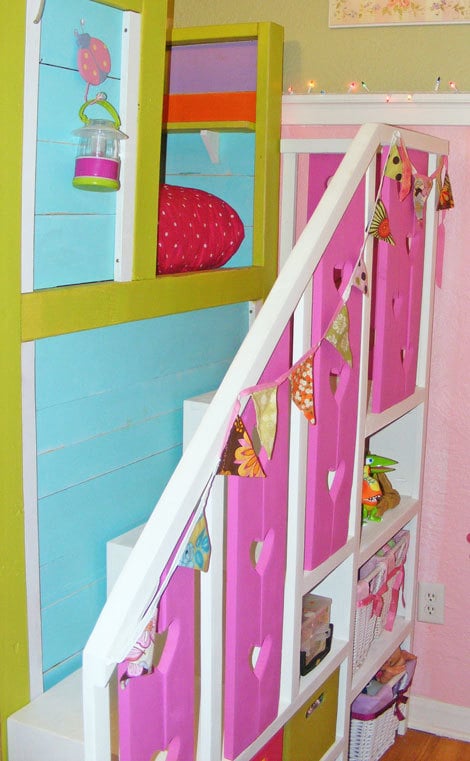
Build oh so charming but functional storage stairs for the Sweet Pea Garden Bunk Bed! Featuring lots of storage, cute heart shaped railing, and stairs perfect for accessing the top bunks, these storage stairs could work for any bunk bed!
This bed is designed and built by Jenny from Birds and Soap.
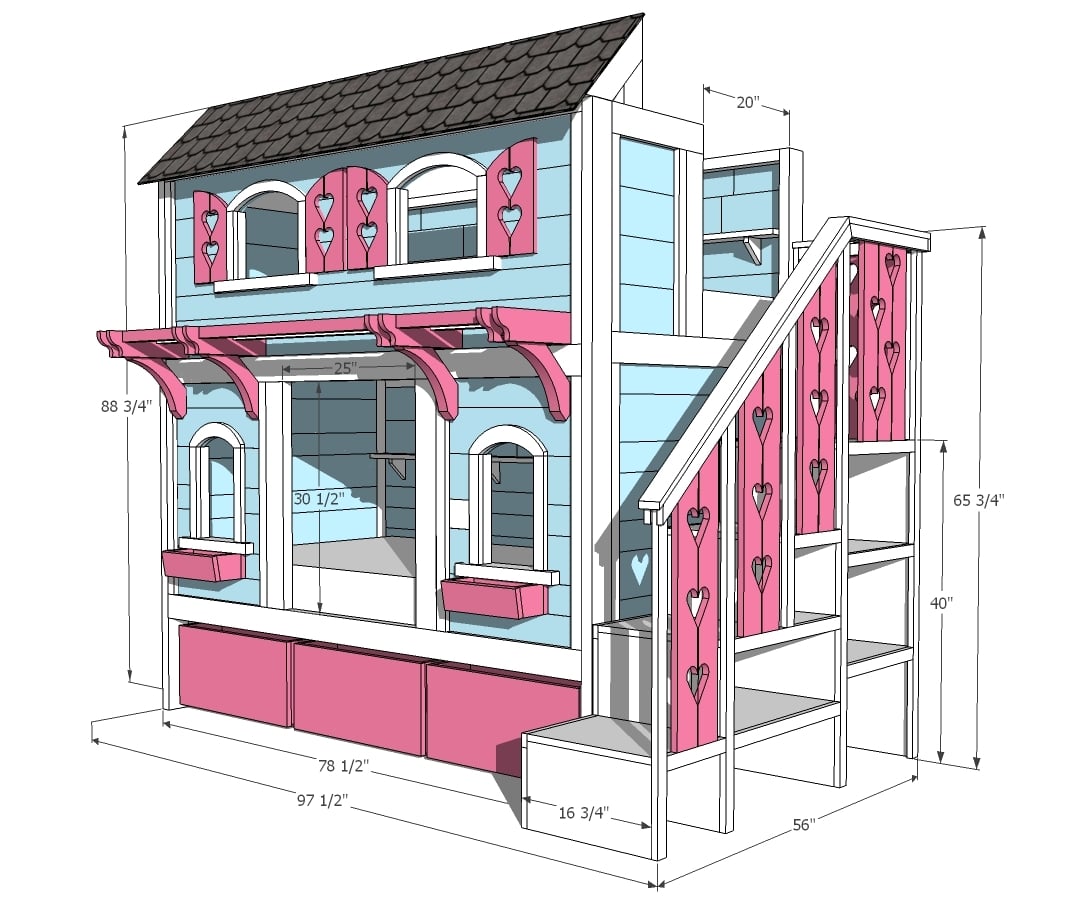
Preparation
For Stairs:
(1) 4x8 sheet ¾” plywood
(14) 1x2x8’s (this size of board is usually really wonky at the store because it is so long and narrow and easily warps as it dries; carefully choose a few boards with at least 65” free from warp to make the tallest vertical trim pieces. The remaining boards don’t have to be perfect because they are cut into smaller pieces and you can scrap the bad parts, but you will need several long boards that are nice and straight) SHOWN IN STEP 14.
(7) 1x4x8’s
(2) 1x3x8’s
Stairs
Refer to diagram for plywood cut layout:
(2) 16x39 ¼” strips of plywood
(1) 16x20” strip plywood
(2) 16x18 ½” pieces plywood
(1) 16x 24” piece plywood
(1) 16x19 ¼” piece plywood
(1) 16x 23 ¼” piece plywood
(2) 16x9 ¼” pieces plywood
(2) 16x 12” pieces plywood
Baluster:
(3) 1x2s @ 65”
(1) 1x2 @ 45”
(2) 1x2s @ 35”
The rest of the 1x2 material for stair/shelf trim and railing trim will be cut to fit.
Decorative stair panels:
(3) 1x4s @ 30” long with cut-out design
(3) 1x4s @ 35” long with cut-out design
(6) 1x4s @ 25” long with cut-out design
1x3” Stair Rail cap piece is also trimmed to fit. Length should be roughly 48” for stair railing with a 40 degree angle at the bottom and a 110 degree angle at the top. Landing trim will measure roughly 20 ¼” with a 70 degree vertical angle on the end joining the stairs and a 45 degree horizontal cut on the opposite end. Third cap piece for rear railing is roughly 18 1/4” long with a 45 degree angle on one end.
Cut plywood as shown in step 14.
Please read through the entire plan and all comments before beginning this project. It is also advisable to review the Getting Started Section. Take all necessary precautions to build safely and smartly. Work on a clean level surface, free of imperfections or debris. Always use straight boards. Check for square after each step. Always predrill holes before attaching with screws. Use glue with finish nails for a stronger hold. Wipe excess glue off bare wood for stained projects, as dried glue will not take stain. Be safe, have fun, and ask for help if you need it. Good luck!
Instructions
Step 1
See step 14 for plywood layout.
For the plan step 1:
Beginning with the two longest pieces @ 39 ¼” and the piece measuring 20” in length, assemble the top stair or “landing” of the stairs. Using wood glue and 1 ¼” pockethole screws attach the 20” piece to the top of the shelf ends.
Next, find the two pieces measuring @ 18 ½”, they will be your shelves. Starting from the bottom of each side, measure and place a mark at 14” and one at 27”. Draw a level line at each mark and align your shelves to sit just below those marks. Attach the shelves using wood glue and pockethole screws.
You should have your first freestanding shelf completed. Check for square and make any adjustments as needed.
Step 2
To assemble the next section of the stairs, starting with the shelf you just made, measure the left end on the outside and mark a horizontal line at 20” from the bottom. Make a level line across. I find it easiest to lay the shelving flat on its side to assemble.
Find your board measuring 24” in length and attach it just below the level line with wood glue and pockethole screws.
Next, find your piece measuring 19 ¼”, attach this piece to the opposite end of the 24” board from underneath using wood glue and pockethole screws.
For the rest of this section, you will attach the center shelf between the ends. Again using wood glue and pockethole screws, attach the 23 ¼” center shelf at 10” from the bottom of the stairs. Check for square.
Step 3
Now you are going to make the two final steps to this set of stairs. Finding your pieces measuring 12” and 9 ¼” long, you are going to make a single step with one of each piece. The 12” pieces will be the top of the step and the 9 ¼” piece will be attached to the left underside using pocketholes and wood glue.
Because these steps are so tiny, I had a hard time fitting my drill in the little cubby to affix them to the larger stairs. If you can manage, pocketholes and wood glue will do the job. If not, you can secure them to the rest of the stairs using a 1x2” cleat attached to the side of the stairs at 9 ¼” high, or you screw them from the inside of the step they are adjoining to. These will create the first and third steps of the stairs. Make sure the third step is glued to the vertical side it is attached to, and also glue and toenail it into the top of the second step, checking for square, of course.
Step 4
The balusters are made up of 1x2 material that is also incorporated into the trim of the open shelving below the stairs.
Starting with the three pieces cut at 65”, you are going to attach them to the top stair edges using wood glue and a nailer. I got all crazy with the Kreg Jig and predrilled a bunch of pocketholes ahead of time to attach my trim pieces. I think a nailgun goes a lot faster and it is much easier filling a few nail holes than trying to paint inside of pocketholes if you ask me!
Attach the first two pieces to the outside corners of the top stair, one on the front, one on the backkeeping the edges flush with the outside edge of the right side. Attach the third 65” 1x2 to the left side of the top stair, with its edges flush to the rise of the top stair and level all the way down.
Next, attach the 45” length with wood glue and a nailer to the front edge of the second step, keeping the edges flush to the rise of the second stair and all the way down. Check for level.
Attach the 35” 1x2 to the front edge of the first step, keeping the edges flush with the rise of the stair. Check for level.
The last baluster will go up after applying the horizontal trim piece to the second step. All of the horizontal pieces are trimmed to fit; your space should measure 22 ½” inches wide. Nail and glue this horizontal piece into place, keeping it flush with the top of the second step and check for level.
The last baluster piece is ready to be installed. Nail and glue this 35” piece keeping the edge flush with the rise of the third step. Check for level.
Step 6
Beginning at the landing, measure the width between the outside edges of the baluster. It should be 20” long with the left side cut at a 110 degree angle. Keeping the balusters level, glue and nail the rail to the vertical balusters with the edges flush and on point.
Now for the stair rail. Measure from the top point of the landing baluster to the top point of the bottom stair baluster. It should be roughly 48-50”. The right end is cut at 110 degrees. Match up the top angle and nail into place, next align the opposite end on point with the top left corner of the bottom baluster. Glue and Nail into place. One by one glue and nail the other balusters to the railing; checking for level each time.
The final rail piece is attached to the rear of the stair landing; it measures 18 ¼” long. Glue and nail into place.
If you didn’t already prime and paint the plywood, it is time to finish the shelving and stair rails.
Step 7
Make the cut-out panels for each stair. Using the 1x4 boards already cut at 30” and 35”, line them up in pairs for step assembly. The three steps will have one short board and one long board. Align each pair of boards so that the bottoms are even. Draw a horizontal line at 8”, 16”, and 24” up across all boards.
I made a heart template measuring 3.5” tall and traced the design on center between the boards so the top of the heart was even with my line. The hearts will be even on the panels. Carefully cut them out with a jigsaw and sand the edges smooth.
For the sections around the landing, the pattern is slightly different. These boards measure 25” tall, and there are three boards per section. The heart pattern is staggered between the three boards. Starting with the left board, place a mark 7” from the bottom and another at 17”. Trace the hearts so the tops are even with this line on the left and center board. With the right board measure 12” up and 19” up from the bottom. Center the heart template between the right and center boards and trace. This will give you four staggered hearts. Repeat this pattern on the other three boards for the other side of the landing. Cut out with a jigsaw and sand the edges smooth.
Step 9
Attach the boards using a nailgun and glue. Starting wit the lower stairs, center the boards on each tread, if you would like a small gap between them, use a pencil placed in between the boards while you nail them in. Glue the boards to the stairs and toenail them in place with a nailer (I used pocketholes here because, again, I got all crazy with the Kreg Jig, but nails will be easier.). Also glue and nail the tops of the panels to the stair rail, making sure that they are level and the gap is even between the boards.
When you have attached all of the decorative panels, there will be a bunch of uneven boards poking over the top edge of your rail. That’s okay, because next you are going to straighten them out in one fell swoop!
Using a circular or jigsaw, cut the boards flush with the angled railing, using the railing as a guide for the proper slope.
Step 10
To trim out the inside railing, you are going to repeat the same steps as you did for the outside railing. Follow the railing, sandwiching the tops of the decorative panels between your rail pieces, attaching with glue and a nailer. When you are finished with the landing and stair slope, trim the end of the rail near the bottom baluster so it is flush on the ends.
Step 11
Railing cap.
The final step is capping off the stair rail with a 1x3 board. Starting with the rear of the landing, Cut the 1x3 to size with a 45 degree angle on the corner.
Cut the next piece with a matching angle to round the corner. The opposite end of the board will get a vertical cut at 110 degrees.
Match up the final trim piece with a 110 degree angle on the adjoining end, measure a half inch past the end of the rail and cut at a 50 degree angle.
Sand the edges, smooth, and paint.
Now take a nap inside this awesome bed because you are DONE!!
Step 13
CUTTING LAYOUT
Starting with the sheet of plywood, fill any knots or holes with wood filler, let dry, and sand the plywood until even.
I would also suggest priming the sheet now.
Cut the sheet of ¾” plywood using a circular saw according to the cut diagram. Take into consideration that a sheet of plywood is exactly 48” wide; with cutting 16 inch lengthwise strips, if you cut at exactly 16 inches on the mark for your first and second strips, the final strip gets shortchanged on account of the kerf of the blade. I would suggest measuring your strips to be 15 7/8” wide, and cutting on the outside of the line, this will compensate for the wood lost from the blade’s path. Does that make sense?
Use a light pencil to mark the dimensions of each piece as you cut so you can grab the right pieces as you assemble. Once all of the pieces are cut, sand the edges, removing any splinters.
It is always recommended to apply a test coat on a hidden area or scrap piece to ensure color evenness and adhesion. Use primer or wood conditioner as needed.


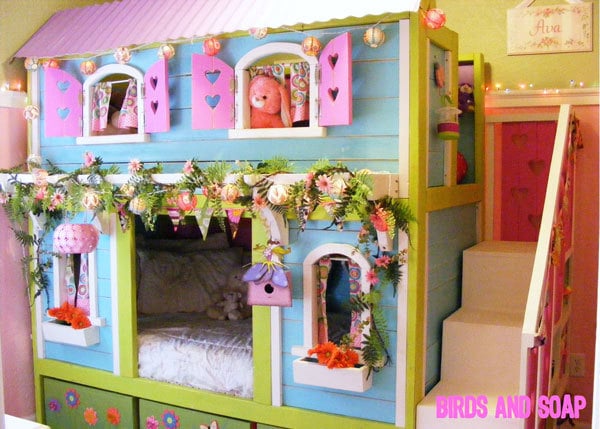















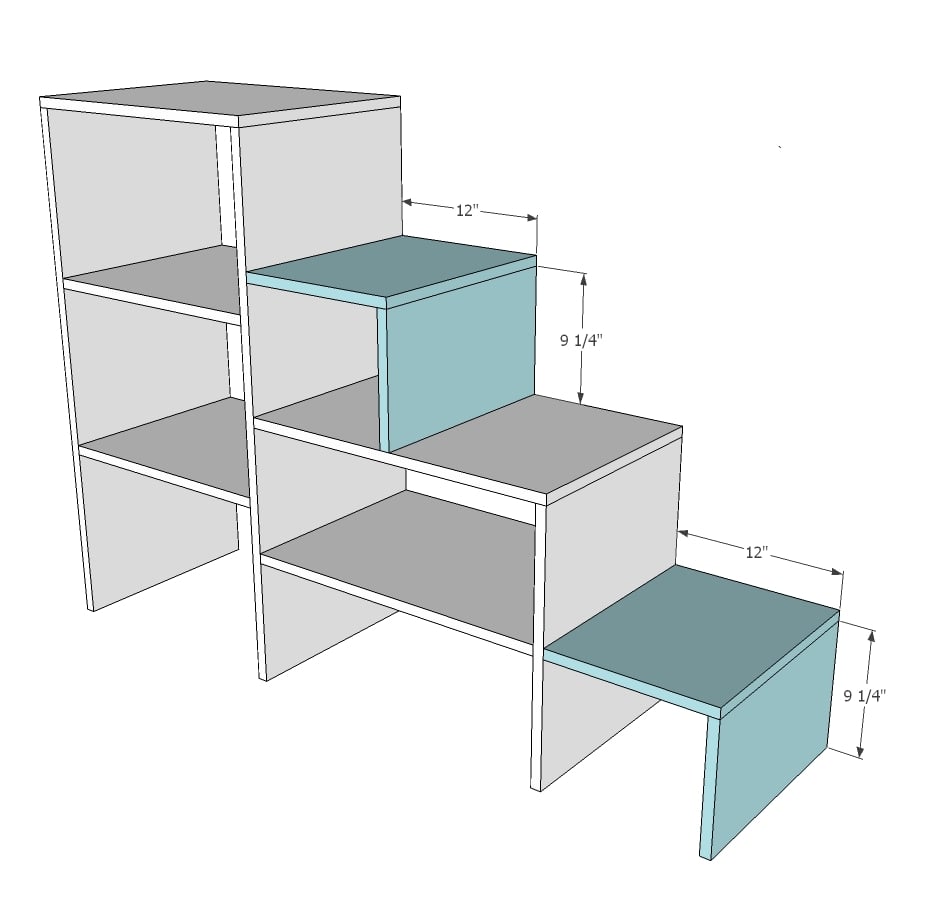
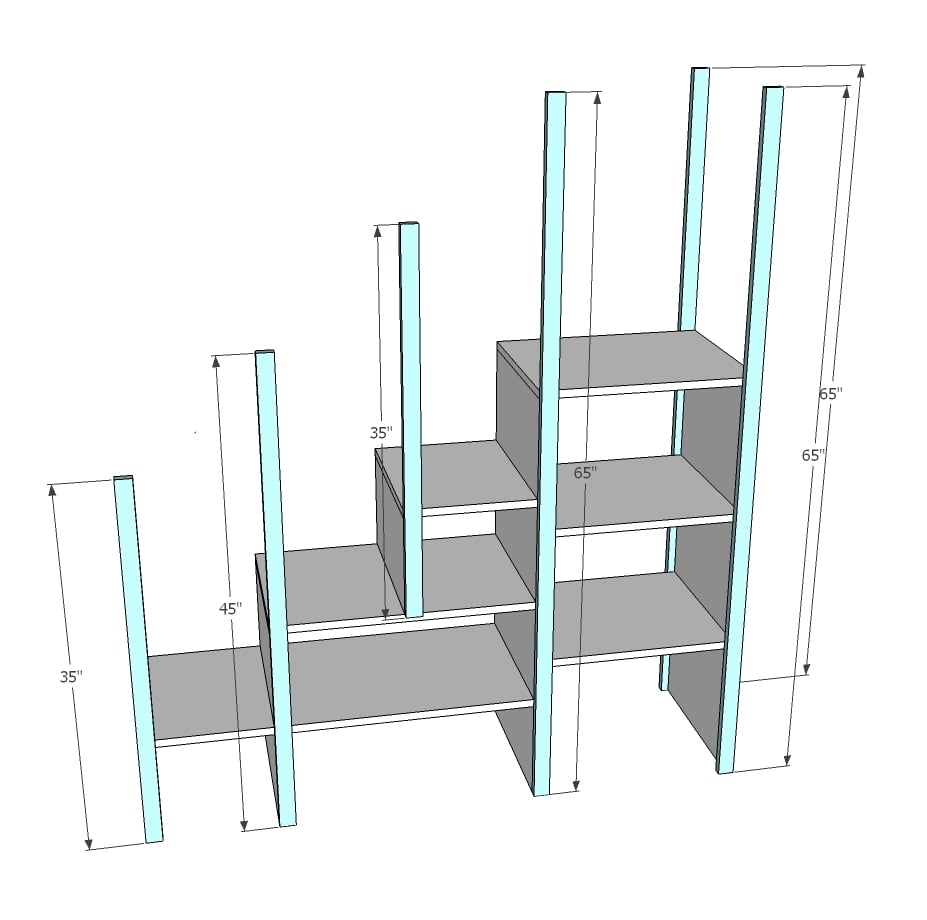
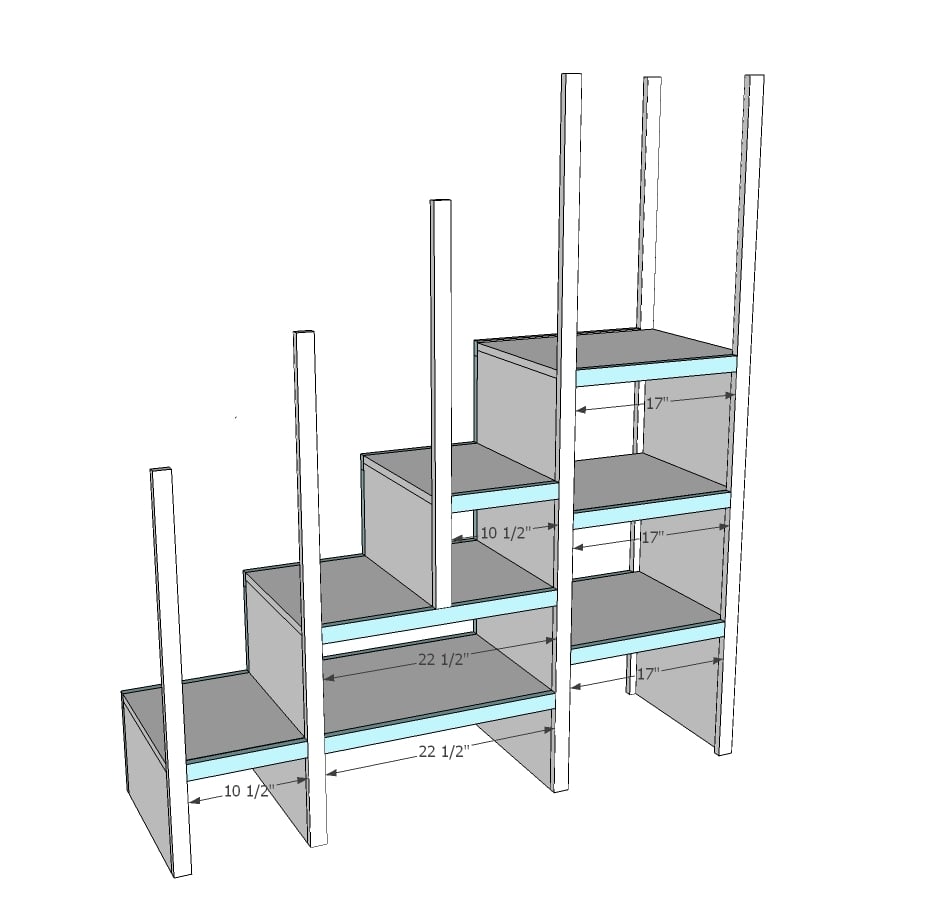

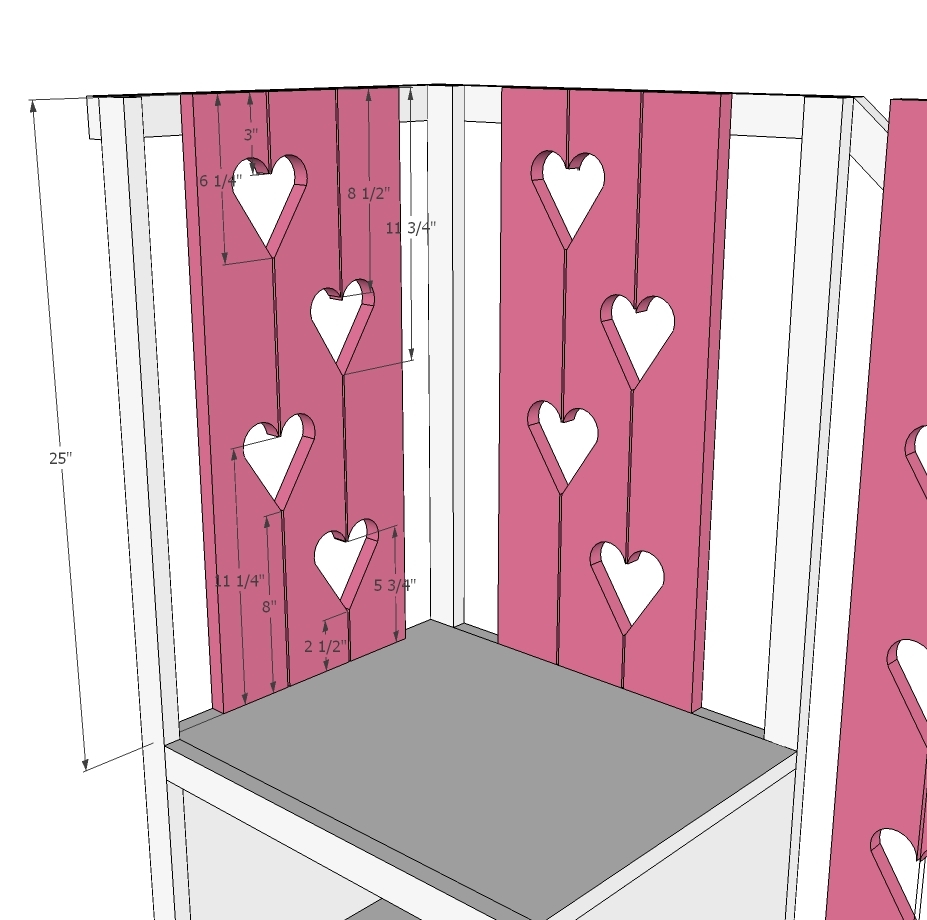




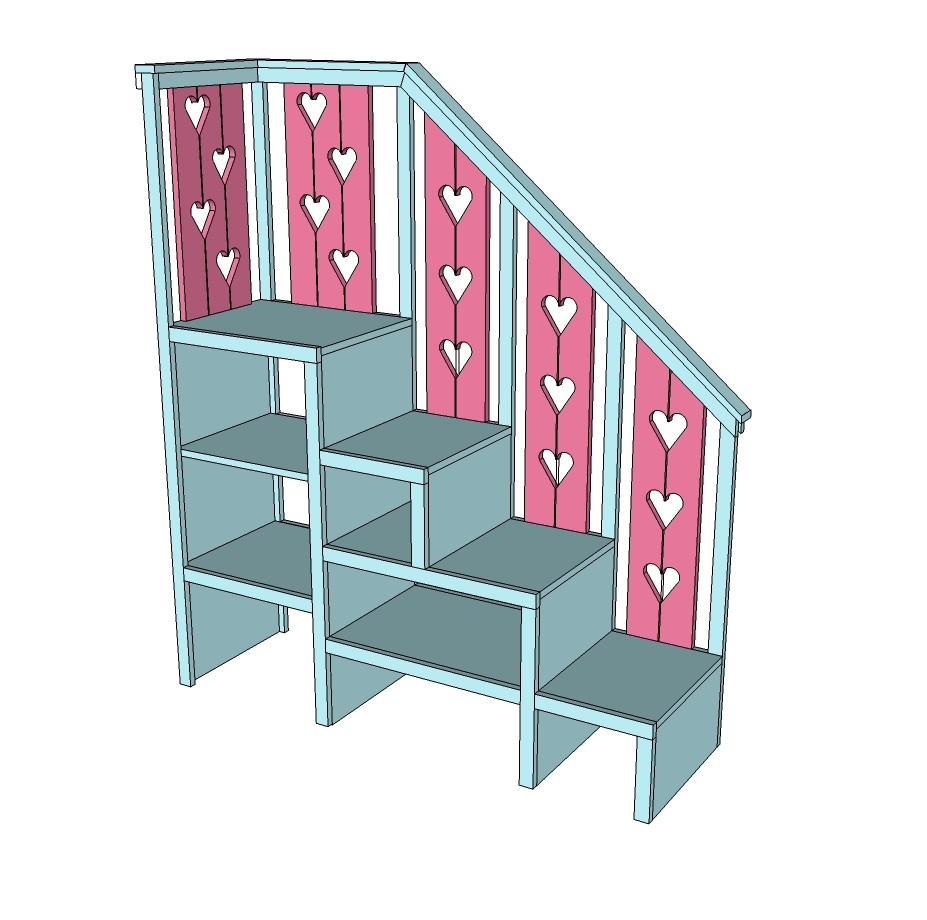
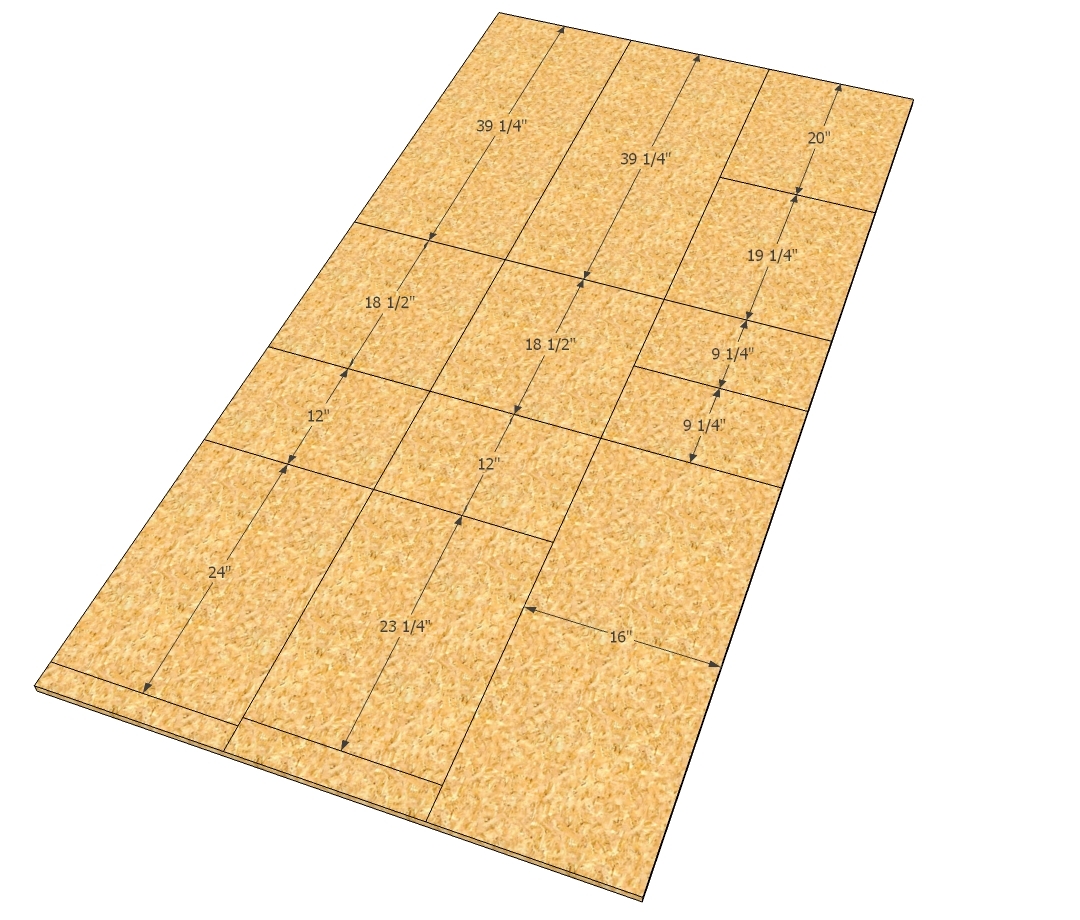

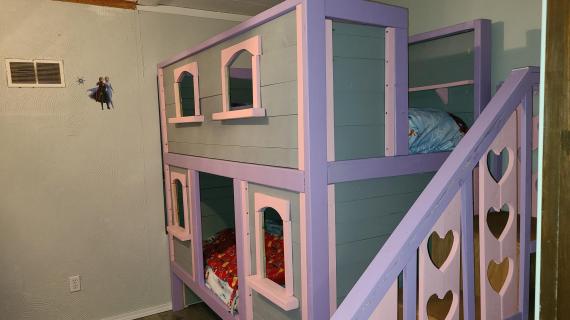
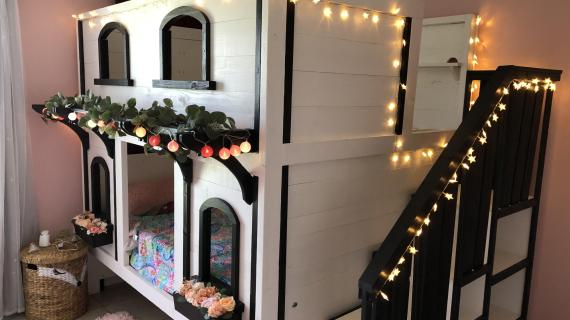
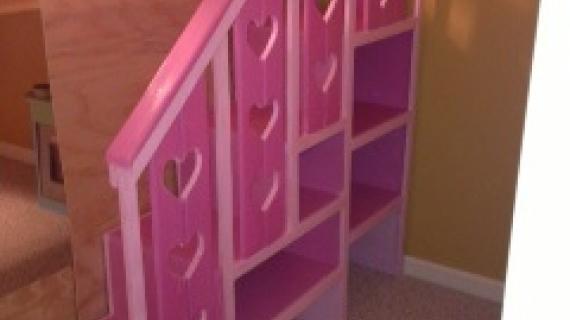
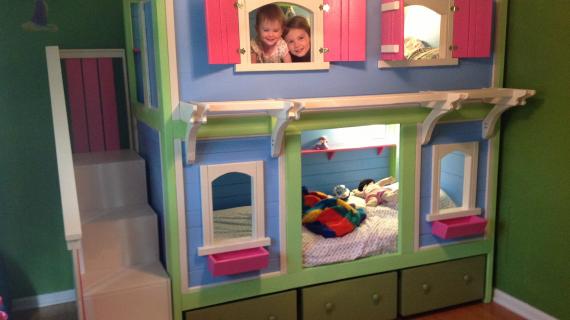
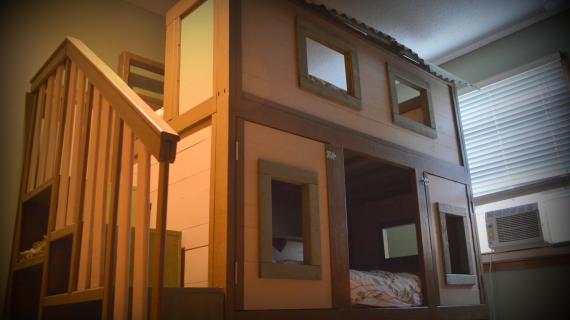
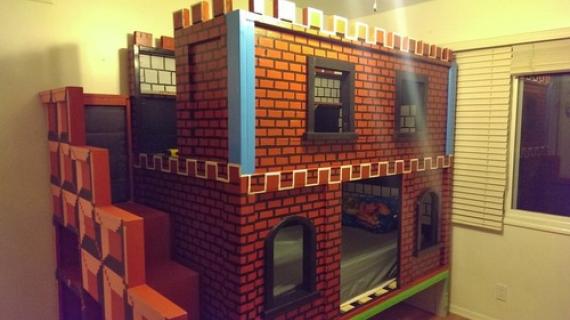
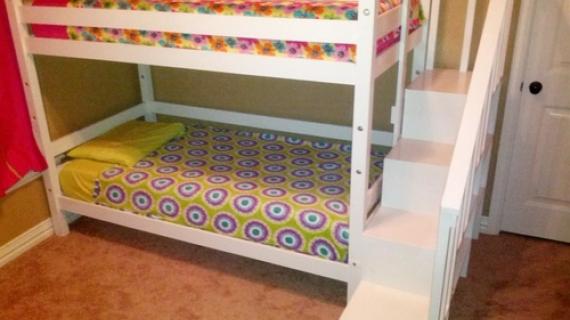

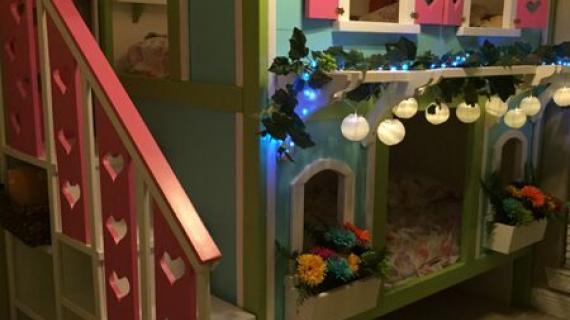
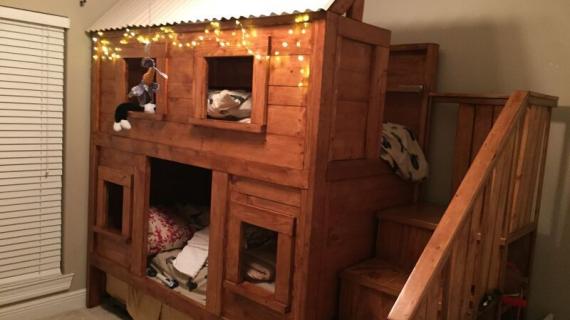
Comments
Aamy0621 (not verified)
Tue, 01/15/2013 - 08:14
Are those stairs strong
Are those stairs strong enough to support an adult?
Anonymous Coward (not verified)
Tue, 01/15/2013 - 10:37
They should be
Amy - If you look at the construction, it's 3/4 inch plywood resting on more 3/4 inch plywood.
That should hold most adults. If you have a really heavy person, add a piece of 3/4 plywood under the upper small box to support the center of the rectangle, and another under that between the floor and the first level of wood. That will send the weight down to the floor.
Bethanywp (not verified)
Sun, 01/20/2013 - 17:52
Did I miss something?
When you go from Step 6 to Step 7 now the inside of the stairs up against the house is trimmed out. Did I miss the directions telling you to also trim out the inside of the steps?? If so, I apologize, but if not does the materials list also cover the wood needed to trim out the inside of the steps?
junior2725
Fri, 03/07/2014 - 23:52
Attachment to Bed
I am just getting started on building the bed so I haven't started the stairs yet, but I don't see it written anywhere on the plans about how the stairs are attached to the bed. Are they not attached? Are they just so heavy that they will not move away from the bed? My goal is to have this bed done and installed by the 17th, so any help would be appreciated. Also I am modifying the plans to make the bottom bunk a playhouse instead of a bed. I am going to leave the wall on the stair side open so the stair storage area is accessible from inside the playhouse. I'm debating on whether I should use plywood on the outside of stairs so the storage areas are enclosed or should I leave them accessible from both sides. What would you do?